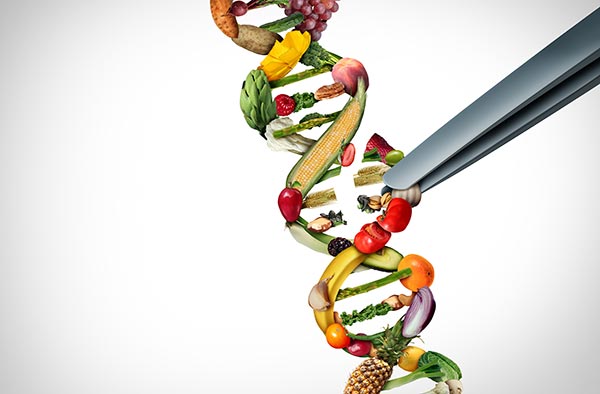
(Article by Dr. Joseph Mercola republished from ChildrensHealthDefense.org)
Story at a glance:
- Pairwise, an agricultural biotechnology company, created Conscious Greens Purple Power Baby Greens Blend, the first CRISPR-edited food available to U.S. consumers.
- The company used CRISPR, or clustered regularly interspaced short palindromic repeat, to edit mustard greens’ DNA, removing a gene that gives them their pungent flavor.
- The greens are first being rolled out in restaurants in St. Louis, Springfield, Massachusetts, and the Minneapolis-St. Paul area, before heading to U.S. grocery stores — beginning in the Pacific Northwest.
- In 2022, researchers with Boston Children’s Hospital revealed that using CRISPR in human cell lines increased the risk of large rearrangements of DNA, which could increase cancer risk.
- Because regulators don’t consider gene-edited foods to be genetically modified organisms (GMOs), they don’t have to be labeled.
Mustard greens are a nutrient-dense source of vitamins and minerals, but their bitter flavor makes them unpalatable to many. To remedy the problem, Tom Adams, cofounder and CEO of Pairwise, told Wired, “We basically created a new category of salad.”
The agricultural biotechnology company, founded in 2017, had raised $90 million by 2021, and $115 million total, “to bring new varieties of fruits and vegetables to market.”
Its first product, Conscious Greens Purple Power Baby Greens Blend, is also the first CRISPR-edited food available to U.S. consumers.
Gene-edited mustard greens coming to U.S. stores
Pairwise scientists used the gene-editing technology known as CRISPR, to edit mustard greens’ DNA, removing a gene that gives them their pungent flavor.
The greens are first being rolled out in restaurants and other locations in St. Louis, Springfield, Massachusetts and the Minneapolis-St. Paul area, before heading to U.S. grocery stores — beginning in the Pacific Northwest.
Pairwise is careful to describe itself as a “pioneering food startup,” trying to distance itself from its true biotechnology roots. It describes the gene-edited greens as:
“A mix of colorful Superfood leafy greens with a unique, fresh flavor and up to double the nutrition of romaine. Using CRISPR technologies to improve taste and nutrition in produce, Conscious Greens are field-grown Superfood greens that eat like lettuce, offering a versatile new option for chefs and salad lovers alike.”
The company has also built a glossy PR campaign to make its motives seem altruistic and necessary to improve Americans’ diets.
In a news release, Haven Baker, Pairwise co-founder, and chief business officer, stated:
“We’re proud to be bringing the first CRISPR food product to the U.S. We set out to solve an important problem — that most lettuce isn’t very nutritious, and other types of greens are too bitter or too hard to eat.
“Using CRISPR, we’ve been able to improve new types of nutritious greens to make them more desirable for consumers, and we did it in a quarter of the time of traditional breeding methods. Launching Conscious Greens through this exciting partnership with PFG [Performance Food Group] is a major milestone in achieving our mission to build a healthier world through better fruits and vegetables.”
But are CRISPR foods really better — or do they pose unknown, and potentially serious, risks to the environment and the people who eat them? Further, it’s not going to stop here. Pairwise is already working on using CRISPR to create blackberries with no seeds and cherries without pits.
The idea that genetic modification is going to compel people to eat mustard greens when they otherwise wouldn’t is also highly questionable. So the company’s claims that its gene-edited products will boost Americans’ nutritional intake are likely to fall flat.
Is CRISPR really an exact science?
CRISPR is being increasingly used to tinker with natural foods. In addition to altering taste, CRISPR is being used to extend shelf life and create foods that resist certain bacteria and viruses.
Whereas genetic engineering involves the introduction of foreign genes, CRISPR involves manipulating or editing existing DNA. It’s said to be “exceptionally precise.”
In an interview with Yale Insights, Dr. Gregory Licholai, a biotech entrepreneur, explained CRISPR this way:
“So as you probably know, our book of life is made of DNA. DNA itself is many millions of base-pairs, which is like a language. And within that language, there are certain regions which code for genes, and those genes are incredibly important because those genes go on to make up everything about us.
“There’s 40,000 proteins that become outputs of those genes and they are involved in our health, our wellbeing, and any defect in those genes becomes problematic and causes disease.
“What was previously attempted with gene editing was to manipulate genetic information in blocks, basically in big pieces. It’s kind of like trying to edit a book by only being able to rip out a page at a time and transfer a page at a time, without really being able to control the actual words. The power of this technology: it literally comes down to the individual letters.
“So the precision is far better than anything that has happened before. The excitement in the scientific community is being able to go in and very precisely make changes in DNA of actual genes that you can actually turn off bad genes or you can potentially repair genes that have got mutations in them where the code is written incorrectly.”
But CRISPR isn’t always an exact science. As is often the case when it comes to tinkering with genetics, gene editing has led to unexpected side effects, including enlarged tongues and extra vertebrae in animals.
Further, when researchers at the U.K.’s Wellcome Sanger Institute systematically studied mutations from CRISPR-Cas9 in mouse and human cells, large genetic rearrangements were observed, including DNA deletions and insertions, near the target site.
The DNA deletions could end up activating genes that should stay “off,” such as cancer-causing genes, as well as silencing those that should be “on.”
Risks of humans manipulating the genetic code
In 2022, researchers with Boston Children’s Hospital revealed that using CRISPR in human cell lines increased the risk of large rearrangements of DNA, which could increase cancer risk. Such rearrangements occurred up to 6% of the time.
In a news release, Boston Children’s Hospital explained:
“CRISPR seems to exacerbate a natural process known as retrotransposition, in which DNA sequences known as “mobile elements” or “jumping genes” replicate themselves and move from one location in the genome to another. Similar to CRISPR, these mobile elements use enzymes to create a double-stranded break in DNA where they insert themselves.
“Retrotransposition is often harmless — in fact, over the course of evolution, mobile elements have come to make up approximately a third of our genome. (Some scientists believe they are actually ancient viruses.) But mobile elements have also been linked to disease, including cancer. When the breaks they create in DNA aren’t repaired, mismatched ends of DNA can join, leading to rearrangements.”
In another warning, researchers attempted to use CRISPR-Cas9 to repair a mutation linked to hereditary blindness in human embryos.
But when they did, it led to “genetic havoc” in about half of the cells, triggering them to lose entire chromosomes.
“We’re often used to hearing about papers where CRISPR is very successful,” Nicole Kaplan, a geneticist at New York University, told The New York Times.
“But with the amount of power we hold … [it is crucial] … to understand consequences we didn’t intend.”
What’s more, Licholai said, is that genes edited with CRISPR may be transferred to other organisms and become part of the environment:
“One of the biggest risks of CRISPR is what’s called gene drive, or genetic drive. What that means is that because you’re actually manipulating genes and those genes get incorporated into the genome, into the encyclopedia, basically, that sits within cells, potentially those genes can then be transferred on to other organisms.
“And once they’re transferred on to other organisms, once they become part of the cycle, then those genes are in the environment.
“That’s probably the biggest fear of CRISPR. Humans manipulating the genetic code, and those manipulations get passed on generation to generation to generation.
“We think we know what we’re doing, we think we’re measuring exactly what changes we’re doing to the genes, but there’s always the possibility that either we miss something or our technology can’t pick up on other changes that have been made that haven’t been directed by us.
“And the fear then is that those changes lead to antibiotic resistance or other mutations that go out into the population and would be very difficult to control. Basically creating incurable diseases or other potential mutations that we wouldn’t really have control over.”
USDA is testing gene-edited insects
Even though the unintended consequences of gene editing are unknown and potentially devastating, the U.S. Department of Agriculture (USDA) is working with a U.S. company to test gene-edited insects in greenhouses.
The insects, spotted wing drosophila, cause damage to many fruit crops. The project uses CRISPR to add genes to kill female drosophila while sterilizing males.
Glassy-winged sharpshooters, which spread bacteria that devastate vineyards, are also being targeted with CRISPR.
A carbohydrate in the insects’ mouth allows the targeted bacteria to stick. Researchers intend to insert genes into sharpshooters’ mouths to make them a nonstick surface, causing bacteria to slide off.
“Chemicals can only travel so far before they degrade in the environment,” Jason Delborne, North Carolina State University professor of science, policy and society, told MIT Technology Review.
“If you introduce a gene-edited organism that can move through the environment, you have the potential to change or transform environments across a huge spatial and temporal scale.”
And therein lies the problem. Once released into the environment, there’s no turning back — and no way of knowing what other changes could occur from this genetic manipulation, at a worldwide scale.
FDA says gene-edited beef Is ‘low risk’
The U.S. Food and Drug Administration (FDA) announced in March 2022 that Recombinetics’ gene-edited cattle received a low-risk determination for marketing products, including food, made from their meat.
“This is the FDA’s first low-risk determination for enforcement discretion for an IGA [intentional genomic alteration] in an animal for food use,” the FDA reported.
The animals’ genes were modified to make their coats shorter and slicker. The genetic modification to their coats is intended to help them better withstand heat stress, allowing them to gain more weight and increase the efficiency of meat production — but at what cost?
While a lengthy approval process is typically necessary for gene-edited animals to enter the food market, the FDA streamlined the process for gene-edited cattle, allowing them to skirt the regular approval process.
The agency stated the gene-edited beef cattle do not raise any safety concerns because the gene modifications result in the same genetic makeup seen in so-called “slick coat” cattle, which are conventionally bred.
But in 2019, Brazil stopped its plans to allow a herd of Recombinetics’ gene-edited cattle after unexpected DNA changes were uncovered.
As with the FDA, Brazilian regulators had determined that Recombinetics could proceed without any special oversight since their gene-editing involved modifying cattle with a naturally occurring trait.
In this case, instead of altering the cattle’s coats, Recombinetics was editing the cattle to be hornless — until something went wrong. A piece of bacterial DNA used to deliver the desired gene had become pasted into a cow’s genome, essentially rendering it “part bacteria.”
Regardless, in 2022, Recombinetics stated its gene-edited meat products would be available to “select customers in the global market soon” while general consumers would be able to purchase gene-edited meat in as few as two years.
Gene-edited foods aren’t labeled
Because regulators don’t consider gene-edited foods to be GMOs, they don’t have to be labeled. However, 75% of Americans want gene-edited foods to carry a label.
As gene-edited foods become more common in the marketplace if you’d like to avoid them, choose organic foods, which cannot be gene-edited at this time.
You can also get to know a local farmer who has no intention of using this technology and grow as much of your own food as possible. This way, you’ll have full control over what is, and isn’t, in your food supply.
Read more at: ChildrensHealthDefense.org
Please contact us for more information.






















